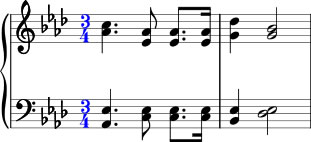Piano Lessons - Time Signatures
Just like key signatures, time signatures are symbols that are found in the beginning of a line of music that give information about the music that you will be playing. The time signature is what gives music the relative strength of each beat, and the number of beats that are in each measure. It is written as two numbers stacked together, and appears after the key signature. Often, the time signature only appears in the beginning of the piece, and will not be written in again unless there is a change in the time signature later on. Even as a beginning piano player, you should start to make a habit of checking the beginning of the first line of your piano music to look for the time signature and make a mental note.
There are some fairly common time signatures that you will spend most of your time playing in, especially when you first begin to learn to play the piano. Once you are familiar with these and realize how time signatures work, you will be able to play music written in more complicated time signatures with no problem at all. Changing the time signature of a piece of music does not change the notes that are to be played, but it can change the value of the notes, or long they are to be hold, in some cases. First, let’s look at how a time signature is constructed and what it means.
The top number of the time signature gives very straightforward information. It simply tells the musician how many beats will be found in each measure. If the top number is four, there will only be four beats of music in the measure. If the top number is three, you can count three beats in each measure, and so on. The beats may be combined or divided in any number of ways, but only that number of beats is allowed to be in a single measure. The bottom number of the time signature can be a bit more complicated. This number tells us which note value gets a single beat. The most common number for the bottom of a time signature is four, which means a quarter (1/4) note gets the beat. You have probably learned by now that a quarter note gets one beat, and that is true most of the time, because this is the most common time signature in use today. The top number is most commonly 2, 3, or 4, meaning that there are 2, 3, or 4 quarter notes in each measure and the quarter note gets one beat. In other less common, but still useful time signatures, the eighth note may get one beat, represented by an 8 as the bottom number. Still others show the half note receiving one beat, by placing a 2 in the bottom position. Although a quarter note most commonly receives one beat, a good musician will be able to play music in any time signature accurately.
Different time signatures are used to give the music a different rhythmic feel to it. In the time signature 4/4, which means there are 4 quarter notes in each measure and the quarter note gets one beat, the first and third beats receive the most emphasis. They are the strongest beats. Think about clapping along with your favorite song on the radio. People tend to clap on the first and the third beats in each measure, because they are the strongest. On the other hand, in the 3/4 time signature, there are only 3 quarter notes in each measure and the first beat is very strong. You may think of the familiar waltz pattern, ONE two three ONE two three, when you think of the 3/4 time signature. Most waltzes are written using this time signature.
To familiarize yourself with different time signatures, try to play music written in several different time signatures, and maybe even music that changes time signatures during the piece, so that you can practice playing in different time signatures. You can also listen to the songs on the radio, and see if you can find music written with four beats in each measure, as well as music written with three, five, or another number of beats in each measure (it is less common, but does exist)! You will be able to tell the number of beats in each measure if you listen for the strong/emphasized beats and try to count the number of beats until the next strong beat.
<< Back to More Piano Lessons ----- Basic Rest Values >>
